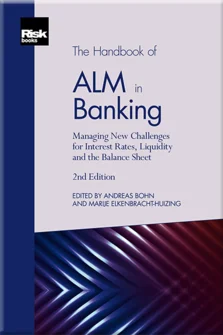Reverse Stress Testing: Linking Risks, Earnings, Capital and Liquidity – A Process-Orientated Framework and Its Application to Asset–Liability Management
Michael Eichhorn and Philippe Mangold
Introduction
Bank Capital and Liquidity
ALM in the Context of Enterprise Risk Management
The New Basel Standards on IRRBB and Their Implications for ALM
Measuring and Managing Interest Rate and Basis Risk
The Modelling of Non-Maturity Deposits
Modelling Non-Maturing Deposits with Stochastic Interest Rates and Credit Spreads
Managing Interest Rate Risk for Non-Maturity Deposits
Replication of Non-Maturing Products in a Low Interest Rate Environment
Managing Mortgage Prepayment Risk on the Balance Sheet
Considerations for ALM in Low and Negative Interest Rate Environments
Credit Spreads
Hedge Accounting
Supervisory Views on Liquidity Regulation, Supervision and Management
Measuring and Managing Liquidity and Funding Risk
Managing Reserve Assets
Instruments for Secured Funding
Asset Encumbrance
Capital Management
A Global Perspective on Stress Testing
Reverse Stress Testing: Linking Risks, Earnings, Capital and Liquidity – A Process-Orientated Framework and Its Application to Asset–Liability Management
XVAs and the Holistic Management of Financial Resources
Optimal Funding Tenors
Funds Transfer Pricing in the New Normal
Balance-Sheet Management with Regulatory Constraints
Reverse stress testing (RST) is commonly understood to be the identification of adverse scenarios that render the business model unviable. Prior to the 2007–9 global financial crisis, few, if any, banks worked on RST. After the financial crisis, regulators and de facto regulatory bodies introduced different requirements and recommendations for banks to perform RST. EY (2013), in a survey of major international financial institutions, noted that the importance of RST as a tool for risk measurement and risk management strongly increased. However, there is still neither detailed regulatory guidance nor an industry standard or “best practice” on how to implement RST in a meaningful way.
While both traditional stress testing and RST involve the analysis of adverse scenarios and their respective impacts, they differ in two key aspects.
- 1.
Direction: in traditional stress tests, banks start by defining a scenario specifying adverse macroeconomic or financial conditions (or a combination thereof). Banks then assess the impact on their business, typically in terms of earnings, and capital and liquidity adequacy, over a specific period of time. Conversely, RST starts by defining
Copyright Infopro Digital Limited. All rights reserved.
As outlined in our terms and conditions, https://www.infopro-digital.com/terms-and-conditions/subscriptions/ (point 2.4), printing is limited to a single copy.
If you would like to purchase additional rights please email info@risk.net
Copyright Infopro Digital Limited. All rights reserved.
You may share this content using our article tools. As outlined in our terms and conditions, https://www.infopro-digital.com/terms-and-conditions/subscriptions/ (clause 2.4), an Authorised User may only make one copy of the materials for their own personal use. You must also comply with the restrictions in clause 2.5.
If you would like to purchase additional rights please email info@risk.net











